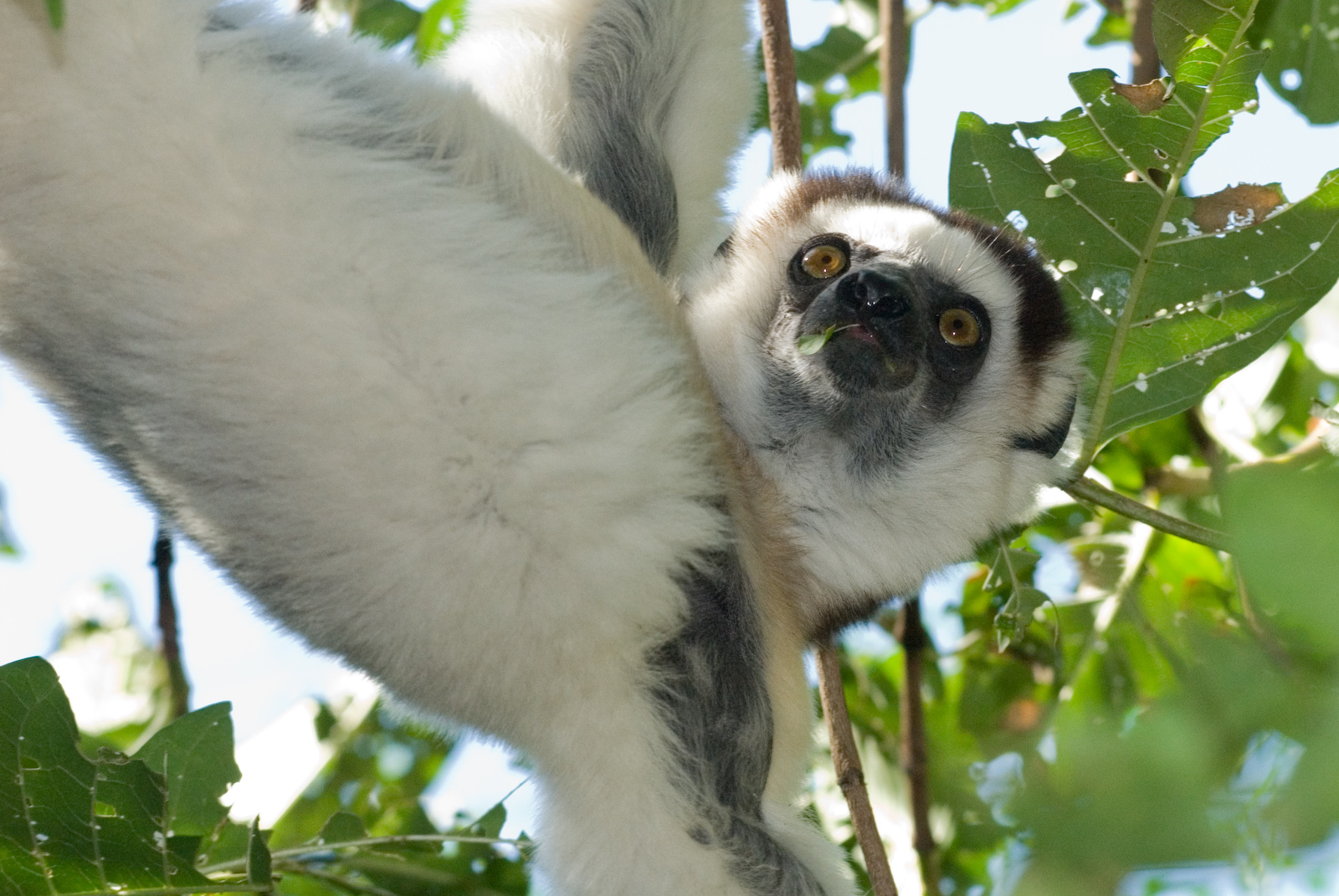- Strepsirrhini
Taxobox
name = StrepsirrhinesMSW3 Groves|pages=111-127|id=12100002]
fossil_range = EarlyEocene - Recent

image_width = 209px
image_caption =Verreaux's Sifaka ("Propithecus verreauxi")
regnum =Animal ia
phylum =Chordata
classis =Mammal ia
ordo =Primate s
subordo = Strepsirrhini
subordo_authority = E. Geoffroy, 1812
subdivision_ranks = Families
subdivision =Cheirogaleidae
Lemuridae
Lepilemuridae
Indriidae
Daubentoniidae (Aye-aye)
Lorisidae
Galagidae The
clade Strepsirrhini is one of the twosuborder s ofprimate s. One of the most distinguishing characteristic of these 118 species is theirwet nose s, and it is this feature for which the grouping is named. The Greek name means having a curved or bent nose (aterpsimbrotos compound of "strepho" "bend" and "rhis" "nose").Madagascar 's only primates (apart fromhuman s) are strepsirrhines, although others can be found in southeastAsia andAfrica .Strepsirrhines are considered to have more primitive features and adaptations than their haplorrhine ("dry-nose", in Greek "simple nose") cousins. Their moist nose is connected to the upper lip, which is connected to the gum, giving them a limit to the facial expressions they can manage. Their brain to body ratio tends to be smaller, indicating a lower intelligence. Their brain's
olfactory lobes are larger, lending to the notion that they have a stronger reliance on smell. Their snouts are generally elongated giving them adog -like appearance, although this is true of somemonkey s, too. Strepsirrhines also have a post-orbital bar, adding to the primitive nature when compared to the suborderHaplorrhini . The strepsirrhines have also retained the ability to enzymatically manufacture vitamin C, which has been lost by all the haplorrhines, including theTarsiidae . [cite journal | journal = Am J Phys Anthropol | year = 1987 | month = May | volume = 73 | issue = 1 | pages = 65–70 | title = Vitamin C biosynthesis in prosimians: evidence for the anthropoid affinity of Tarsius | author = Pollock JI, Mullin RJ | pmid = 3113259 | doi = 10.1002/ajpa.1330730106]With the exception of the
Aye-aye , all strepsirrhines have atoothcomb —tightly clusteredincisor s andcanine teeth —that is used for grooming. Another grooming adaptation is a claw on the second toe of all strepsirrhines, while the big toe is widely separated from the others allowing a vise-like grip for locomotion.About 75% of species are
nocturnal and all of these have a tapetum, a shiny, reflective layer in the back of their eyes, although several diurnal species like theRing-tailed Lemur have it as well. Many of the nocturnal species also have very sensitive hearing and ears they can move independently to capture sounds even better.Strepsirrhine reproduction differs greatly from haplorrhine reproduction. Instead of an individual cycle, strepsirrhines have a breeding season. They also have a litter of offspring and the females have a Y-shaped (bicornate) uterus and multiple sets of nipples.
Classification and evolution
The suborder Strepsirrhini is composed of seven families split into three groups. The first group is the infraorder
Lemuriformes , four families of creatures typically calledlemur s. The other three families are split with theloris es,potto s and thegalago s in the infraorderLorisiformes , and theAye-aye alone in its own family. However, the Aye-aye's placement is tentative. It is placed in its own infraorder (Chiromyiformes ), and it is uncertain whether this infraorder split off from the ancestral strepsirrhine line before the lemurs and lorises, or after.Early classification schemes broke the Primate order into the suborders Prosimii (
prosimian s) and Anthropoidea (simian s - monkeys andape s). However the prosimiantarsier s have been shown to be more closely related to thesimian s, and so it has been moved into the Anthropoidea, which is now renamed as Haplorrhini and Prosimii renamed as Strepsirrhini. Other classifications split Strepsirrhini directly into four superfamilies: Daubentonioidea, Lemuroidea, Loroidea (including Cheirogaleidae) and Indroidea. However, significant evidence suggests that Cheirogaleidae is not related to the lorises, and that Indridae is sister-group to Lemuridae.If the Aye-aye represents a group that is ancestral to all the rest of Strepsirrhini, then it evolved away from the strepsirrhine line between 63 million years ago (mya) (when the strepsirrhines split from the primitive primate line) and 50 mya (the lemur/loris split). If Chiromyiformes is to be considered as the sister only to the lemurs, then it must have evolved after the lemur/loris split 50 mya.
The strepsirrhine phylogeny has also been elucidated by
Retrotransposon presence/absence data.The
adapid s are anextinct polyphyletic grouping that were most certainlyprosimian s and closely related to the strepsirrhines. Theomomyid s are another extinct group of prosmians but they are believed to be haplorrhines, closely related to the tarsiers, but an outgroup to the rest of the haplorrhines.* ORDER PRIMATES
** Suborder Strepsirrhini: non-tarsier prosimians
*** InfraorderLemuriformes
**** SuperfamilyCheirogaleoidea
***** FamilyCheirogaleidae : dwarf and mouse lemurs (31 species)
**** SuperfamilyLemuroidea
***** FamilyLemuridae : lemurs (19 species)
***** FamilyLepilemuridae : sportive lemurs (22 species)
***** FamilyIndriidae : woolly lemurs and allies (18 species)
*** Infraorder Chiromyiformes
**** Family Daubentoniidae: Aye-aye (1 species)
*** InfraorderLorisiformes
**** FamilyLorisidae : lorises, pottos and allies (9 species)
**** FamilyGalagidae : galagos (19 species)
** SuborderHaplorrhini : tarsiers, monkeys and apesReferences
* Roos C, Schmitz J, Zischler H (2004) Primate jumping genes elucidate strepsirrhine phylogeny. Proc Natl Acad Sci U S A 101: 10650–10654.
* "Primate Taxonomy" (Smithsonian Institute Press, 2001), Colin Groves (ISBN 1-56098-872-X)
* "Primates in Question" (Smithsonian Institute Press, 2003), Robert W. Shumaker & Benjamin B. Beck (ISBN 1-58834-176-3)
Wikimedia Foundation. 2010.
